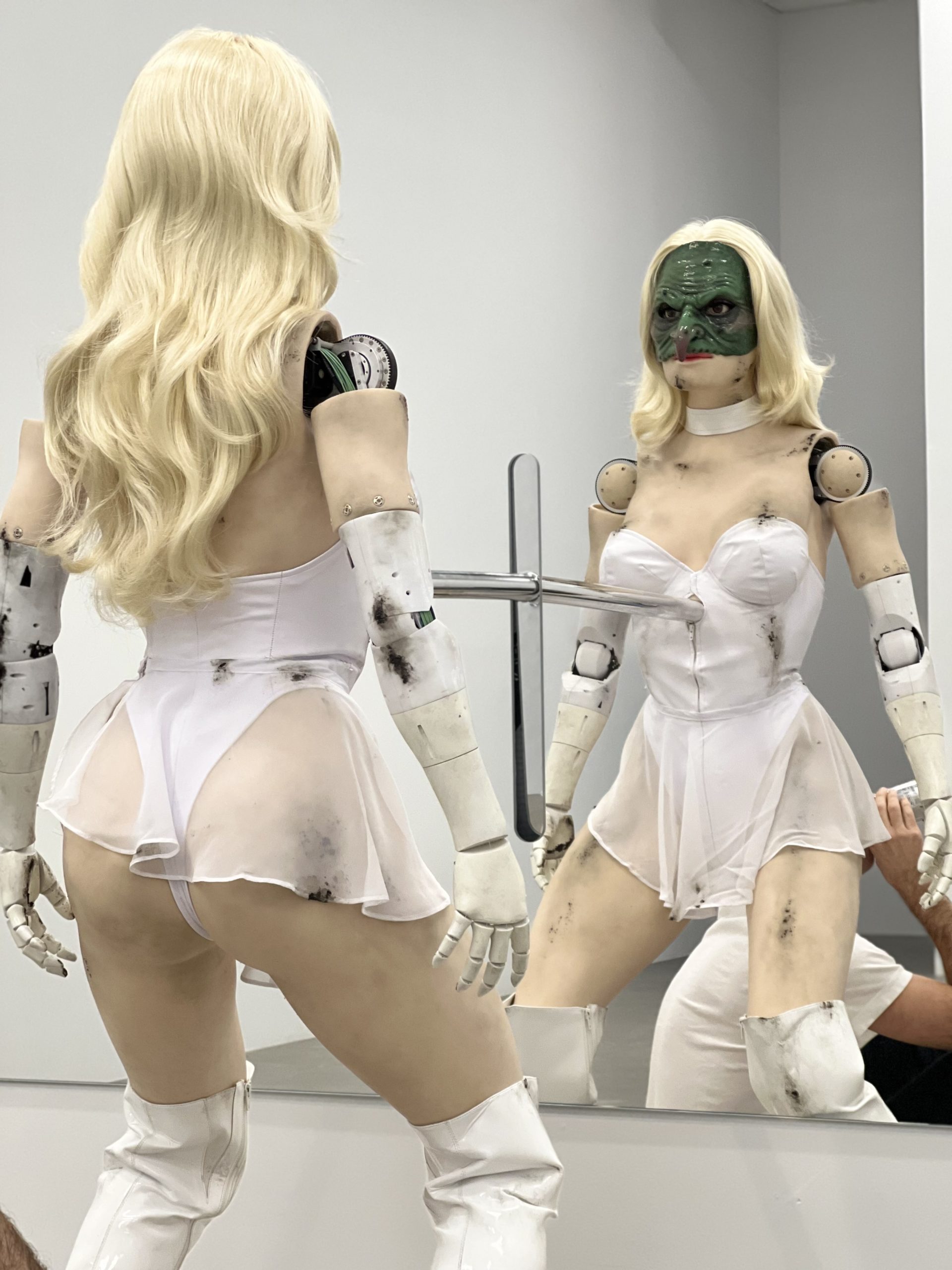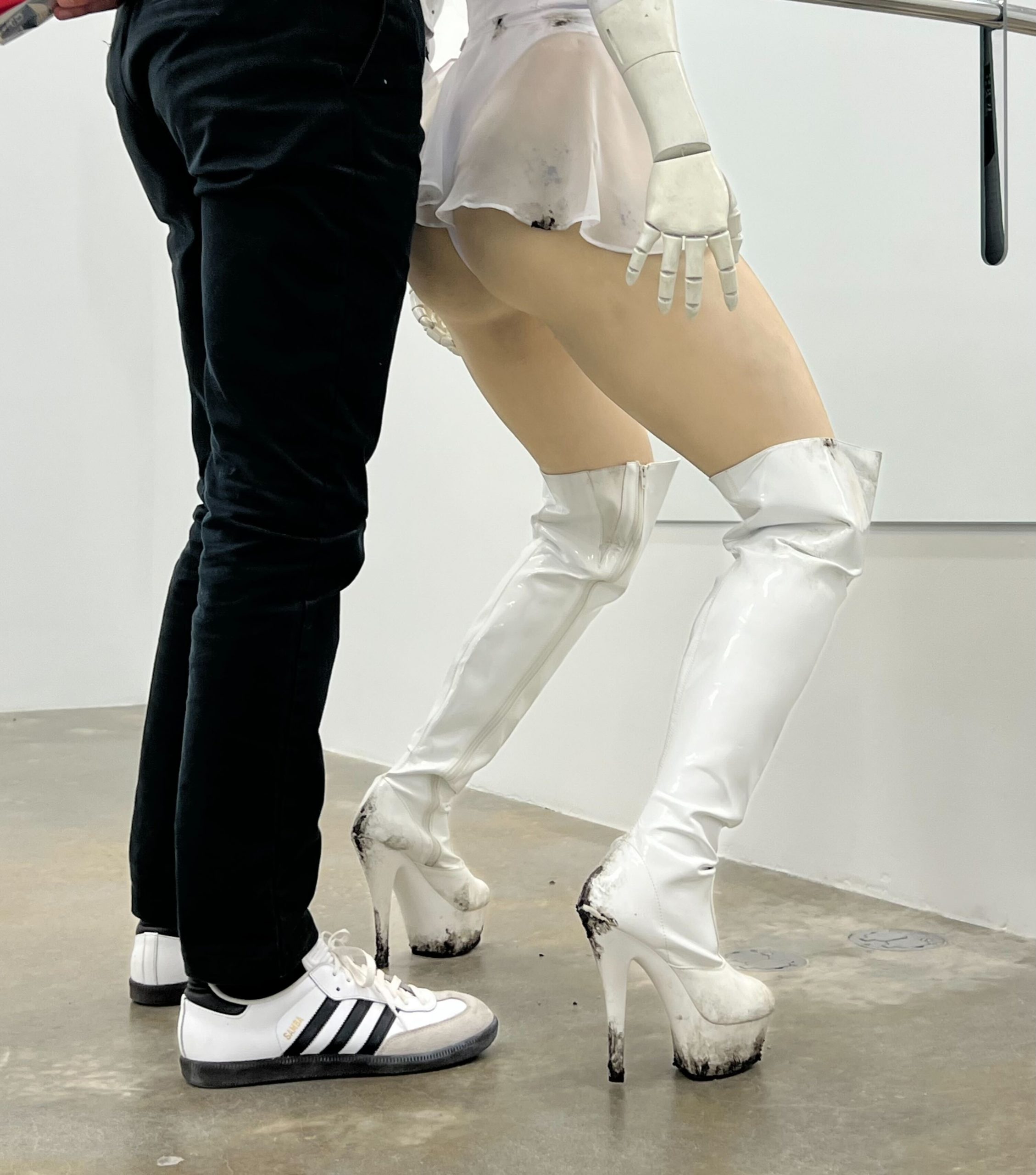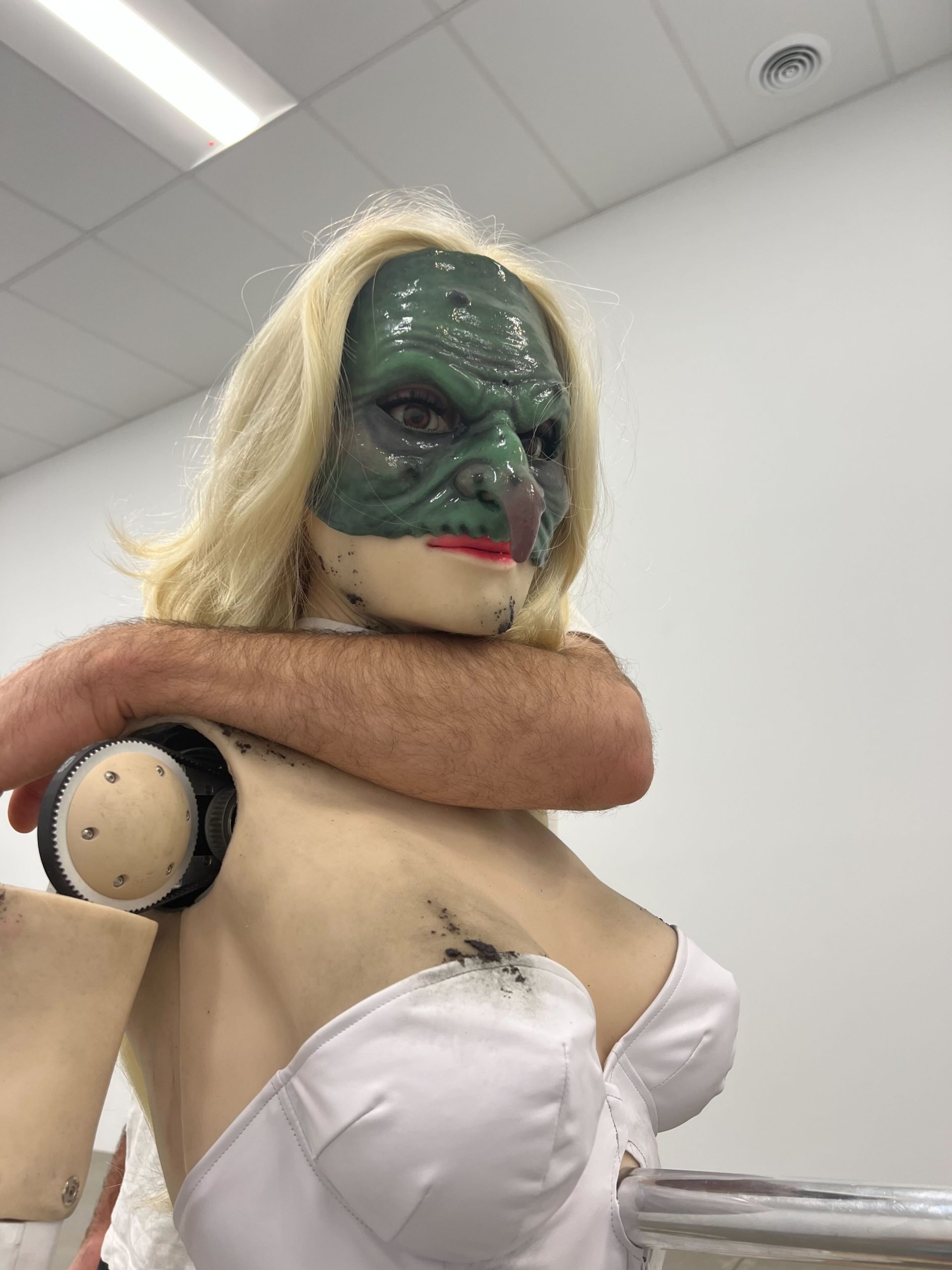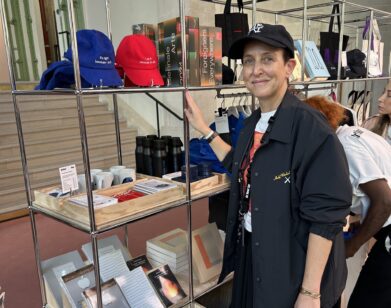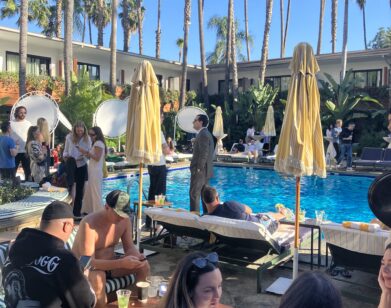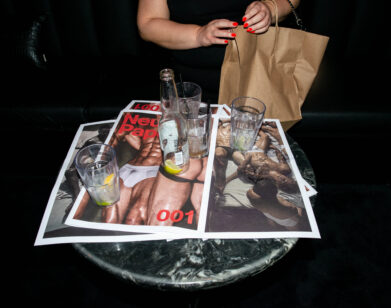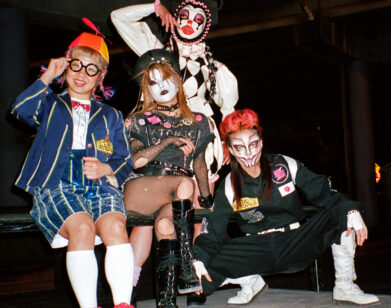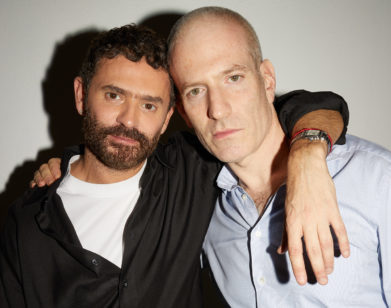TRIGGERED
Jordan Wolfson Just Wants You to Trust Him
When Jordan Wolfson unveiled his phantasmic sculpture (Female Figure) in 2014 at David Zwirner Gallery in Chelsea, it caused such a stir of curious anxiety that lines formed to get a glimpse of it. Wolfson’s life-sized animatronic work gyrated in front of a mirror to pop songs wearing a long blond wig and a sexy white bunny outfit. But there was nothing easy to consume or digest when trapped alone in a gallery space with this nymph Frankenstein, who looked as if it had dragged itself across gravel to get here, its eyes periodically making contact with the hapless viewer while half its face was covered in a monstrous mask. Wolfson managed, in a single work, to capture the unease coursing through so much of our present culture—the repulsive lure of technology and the one-way consumption of bodies—that the success of the piece belied the years of research in animatronics that the artist undertook to develop his creature. Now (Female Figure) is back in Manhattan, this time on view in the East Village at the Brant Foundation Art Study Center, when our cultural anxieties seemed to have only grown more frazzled. On the occasion of the sculpture’s exhibition, Wolfson, who lives most of the time in Los Angeles, talked with his fellow art upstart Anne Imhof, who he calls “a female version” of himself, about provocation, interactive art, and the difference between representing and endorsing violence.
———
IMHOF: Did you always know that you wanted to be an artist?
WOLFSON: It happened in a flash when I was 16 years old. It just sort of hit me like a lightning bolt that I would be an artist. Before that, I didn’t have much confidence. I was kind of a frustrated person. I thought I could be a professional skateboarder or something, or a comedian or a graphic designer. I didn’t know. And then one night it just hit me like a lightning bolt. And I had all this confidence that I never had before.
IMHOF: What made that confidence?
WOLFSON: I think it was just something in my brain. I’m diagnosed as neurodiverse and so my brain fits together in a weird way. I have so many learning disabilities that I have to learn how to do things in certain sequences and I have to figure out what those sequences are. And somehow art was a very immediate sequence for me. It was less complicated than other sequences for some reason.
IMHOF: I was thinking about things we have in common, because you asked me to do this interview with you and I thought, “Why?” Our friendship is kind of young, so we haven’t known each other for that long. Still, I think we have some things in common. We both have no hobbies, maybe?
WOLFSON: Yeah, we have no hobbies but working out?
IMHOF: Besides training.
WOLFSON: Yeah.
IMHOF: When we first met, you and I, it was on the piers in New York, right?
WOLFSON: Yeah.
IMHOF: Which I found interesting. Right away we were talking about art. And you showed me your new work, do you remember?
WOLFSON: Yeah, I remember.
IMHOF: It struck me, because I remembered your work or what I’d seen of it until then, and I thought about how there were a lot of things around you that all had faces. So that was one thing. And the work that you are occupied with right now, has no face–
WOLFSON: No face, yeah. It’s weird for me, that it doesn’t have a face. But I realized that I had to get away from the face in order to progress. I had to challenge myself to move out of the face, however that would mean. I don’t know how to talk about it, really. Let me think for a second. I made a piece called Con Leche, where there were Diet Coke bottles. Did you ever see it? Filled with milk, and they’re walking, they have no faces.
IMHOF: That’s true. But they’re many, so they become a group. It’s less empty than what I mean when I say the new work that you’re occupied with has no face. It is reduced to something that has to create emotions. It’s still very emotional seeing it. Even though you showed me on your phone and it was a video, it still created a very immediate reaction from me that had to do with emotions. I wanted to talk about that, because it was about composition and creating emotion without having a face. What was striking about this is the choreography of the composition. This piece is so much about composition, and it still has hands. Do you want to talk about that?
WOLFSON: All the ideas just come to me. They’re like downloads. They’re like someone pouring milk into a glass and it takes a form. I just get the idea and I try not to judge it. I try to just do the idea, rather than know it or dissect it. I find that that’s not productive for me. This isn’t an intellectual practice. It’s more like a very intuitive practice. And I’ve had my most success when I just surrender to this intuition and try to capture the purity of the intuitive idea. I try not to have ideas for my work unless I’m in front of it.
IMHOF: Hmm…
WOLFSON: How do you work? Is it similar?
IMHOF: I think there are similarities, because I don’t do anything else, mainly, so it surrounds me all the time. It’s all I think about, basically. It’s the strongest relationship that I have, I guess. There is a certain power in your work that I see. In Germany, you say “kraft.” It’s a bit different from “power” in English. It’s kind of something that comes from the inside, that has to do with the search. You’re quite provocative to me, quite blunt. Even though the situation might not be very pleasing, you get strong feelings out of me, you expose me, I feel vulnerable. And then you reveal stuff. You rip a veil from my soul, basically, when we are in normal conversation.
WOLFSON: It’s funny, because I think of you as kind of the female version of me, from Germany. Even though you’re not. You’re you. But you’re me as a kind of strong German. [Laughs] I see a dimensional version of myself and when I see you, I see someone who’s potentially experiencing or has experienced similar pressures and also similar blisses that I’ve experienced: creative bliss, but also creative pressure. So I feel very connected to you like that.
IMHOF: I wanted to prepare for the interview and I read somewhere that you have been in shows from a crazy early age. A lot of shows. I read somewhere that you’ve shown with Andy Warhol and Isa Genzken and I was kind of like, “What? Okay.” And then I thought, “Okay, both of them are quite lonely, right?” Andy Warhol had quite a lot of figures around him. There’s a strong magnetism that he had. He worked with Isa. A lot of artists count her as an idol.
WOLFSON: She’s an idol for me, completely.
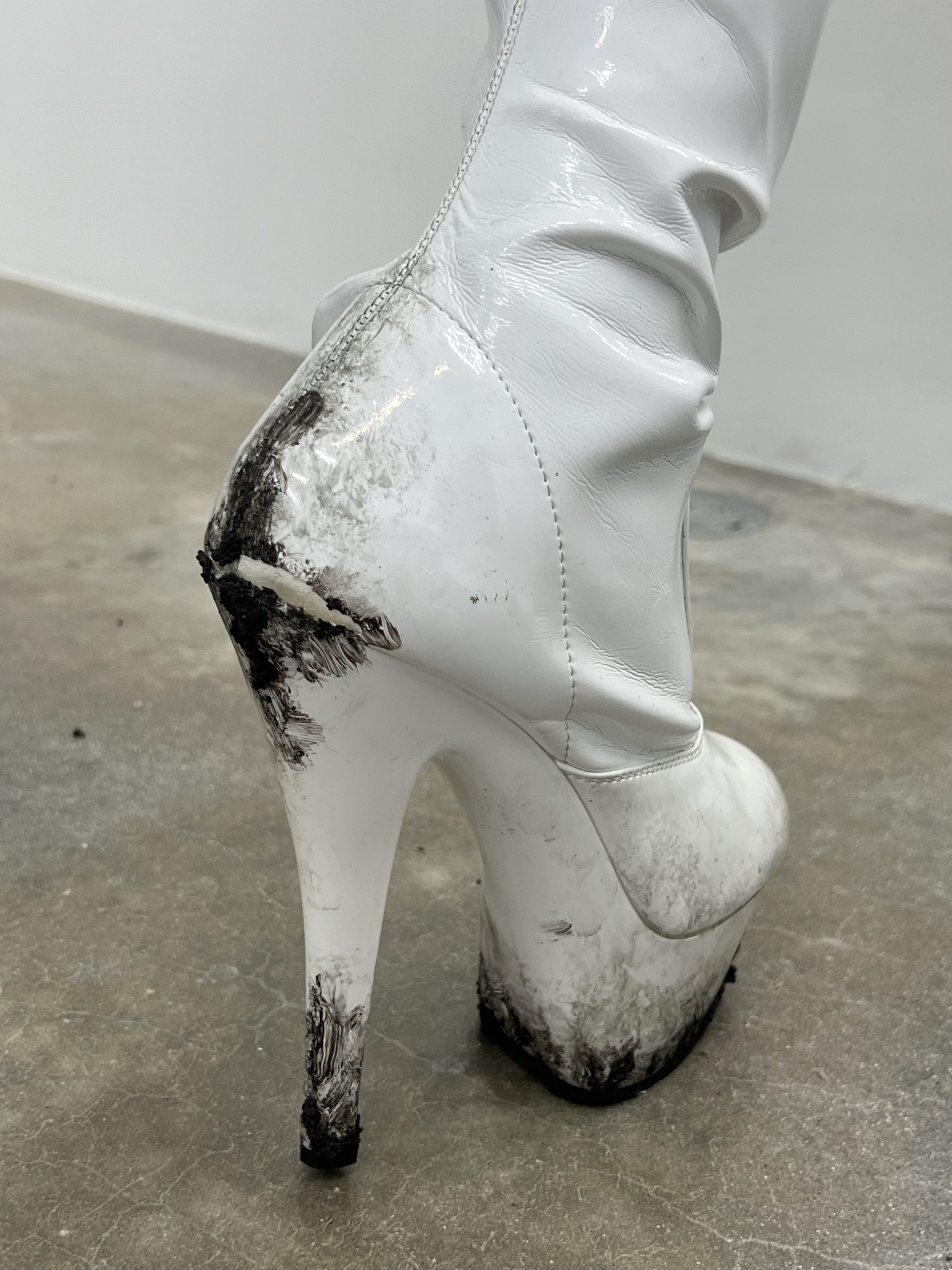
IMHOF: Yeah. And I thought about people like Elizabeth Peyton, for example. She has all these portraits that she makes of her friends and people she is in love with. She’s creating all these artworks that have to do with relation, that have to do with people and friendship. I was struck thinking about your work more, and Female Figure, in terms of these characters that you create. You reach out with them. And you also put them in a position between you and the spectator or the viewer. Maybe they are, in a way, as provocative as you.
WOLFSON: The art is as provocative as I am?
IMHOF: Yeah. So when I see Female Figure, for example, and you can deny this of course, but when I see it, she talks with your voice. I heard the first words out of her mouth and that was such a strong poem to me. “My father’s dead, my mother’s dead, I’m gay.”
WOLFSON: Yeah, “My mother’s dead. My father’s dead. I’m gay. I’d like to be a poet. This is my house.”
IMHOF: “I’d like to be a poet” was something that struck me a lot. And I thought, “Okay, Jordan’s work is about that.” It’s poetry. You work with so many different media, but it’s this idea of having a figure speak, having words in it, having these connections in between images. I read an interview where you said something that you don’t like is art that is participatory.
WOLFSON: I don’t like interactivity. I hate interactivity.
IMHOF: I was just thinking about it, because I was doing something computer generated that I would install in Amsterdam. For a moment I thought, “What if it had eyes following?” But it was basically too much for me. Too much participation, almost. Why do you think interaction is something that you don’t like?
WOLFSON: I’m a very conservative artist and this idea of interactivity and how interactivity negates the experience of the art, it’s really just Marshall McLuhan stuff, where he talks about different types of media. The telephone is a hot medium, because there’s an exchange between two voices, but the radio is a cold medium, because there’s just one voice speaking and you can never speak back to the radio. I want my interactivity to be cold. And so, in a way, Female Figure is like a radio that looks at you, but it’s not a radio that speaks with you. I would say the same with Colored Sculpture and also the same with the third piece, Body Sculpture. It was about isolating and controlling the viewer in a way, wherein I could create a kind of formal bridge that could carry any type of content over it. And with Female Figure, the eye contact negates the idea of the artwork being a spectacle. Because the minute the artwork looks at you, you cannot look away and you cannot look at its body. You must look right in its eyes and you’ll be enormously distracted if you try to look away from it.
IMHOF: Did you think of this artwork as a spectacle? I don’t know where you showed Female Figure the very first time, but I wanted to look at your work and I didn’t manage because there was such a long queue. In a way, the Mona Lisa is a spectacle, right? Because people make it one.
WOLFSON: People make it a spectacle. It’s just a painting.
IMHOF: But it is a spectacle, because people are there.
WOLFSON: This is why I only allow four people in the room at a time, because if access to the piece was unlimited it would become a spectacle.
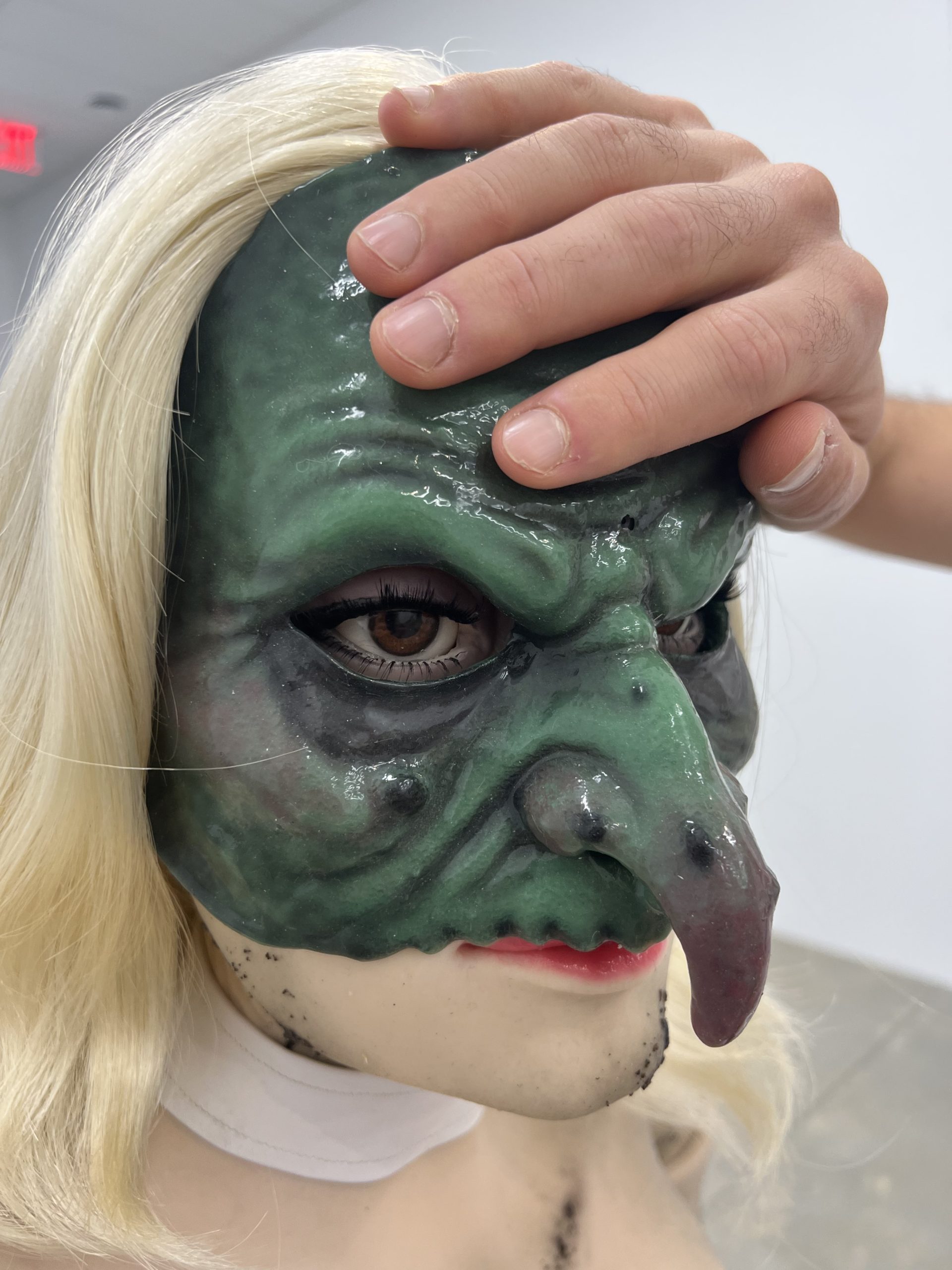
IMHOF: Did you succeed with that?
WOLFSON: Yes. When it’s your artwork, everyone does what you say. [Laughs]
IMHOF: I know. But you can only say so much about your intention. I experienced that with my own work, wanting it to be a certain way, to preserve some kind of aura, to make sure the work is not totally at the feet of its audience. I have a love-hate relationship to the word experience and life and performance. I’m not saying that it’s the same with your work. I think it’s interesting with Female Figure. It’s like a doll, it’s a monster in a way. It has this kind of manipulative aspect towards the audience that totally works. And you include the mirror inside of it. It’s basically the machine looking inside of the mirror. There is also rape in the air with that figure, no? It has dirt stains on it. There is something that has happened to it, beforehand.
WOLFSON: I never thought of that. People have always asked me, “Has the sculpture been assaulted?” I always remind them that the sculpture is dirty, but it’s not bruised, it’s not hurt. It’s just dirty. I always thought that there was some type of light narrative that the sculpture had freed itself from something, but now, after its freedom, it is a prisoner once again.
IMHOF: It appears as a very proud thing, even though it’s dirty. You could imagine what happened before, but there’s also a future that’s not there yet when you look at it. Can you talk about that aspect of non-participation in your work? I think it’s called Violence.
WOLFSON: In Real Violence?
IMHOF: Yeah.
WOLFSON: I mean, Real Violence was about taking an actual interactive medium and then reducing its interactivity concentrically. In order to reduce the interactivity, you go through a number of distorted situations. The first distortion is a physical distortion and the camera turns from the sky. Then there’s also a contextual distortion, where you hear the Hanukkah prayer. And then there’s another contextual distortion where you witness this murder, essentially. And you can’t do anything about it, except look or look away.
IMHOF: As a viewer, you can’t even really look away.
WOLFSON: You could look away if you wanted to. What was interesting is that we actually created some programming and tested it, where when the violence occurred, the interactivity in the headset just stopped and that you couldn’t look away anymore. But it formally didn’t work, for whatever reason. That’s the thing about art making. There’s no absolutes. It’s all intuitive. It’s all about feeling: the first step of feeling, the second step of feeling, the third step of feeling, just feeling your way through things. What I find fascinating about the artmaking process is that it’s not linear. There’s no formula. I’m constantly lost.
IMHOF: Totally. To my understanding, you’re describing it as a process that’s in the viewer, looking at your work, but also in the artmaking process? It’s something we do first, then the viewer experiences it in a similar way. You had to be the voyeur of your own thing at one point to get the idea, and then it becomes the revival of it.
WOLFSON: With Real Violence, I was watching YouTube clips of people recording violence on the street, right?
IMHOF: Yeah.
WOLFSON: So it was basically witnessing violence mediated through technology and social media. I was watching that and observing my own reaction to it. And I kept on having a hypervigilant reaction to watching this violence. It was horrible.
IMHOF: There’s an interesting juxtaposition between the stillness of the person watching it and the physical action that you witness, the destruction that you witness.
WOLFSON: People walk by acts of horror every day on the street. When you see someone suffering on the street and you don’t help them, you just walk by and you forget about it quite quickly. Watching acts of violence mediated through the internet, there’s nothing you can do. I mean, there is something you can do, you can react to it, you could write about it, you could do whatever. But there’s nothing to literally do at that moment. I was always interested in how Female Figure is related to this as well, how human beings react to representation. The representation of sexuality, the representation of violence. I find it very primitive and I’m very interested in it. I’m interested in these primitive reactions, how we’re primitively reacting to stimulation. I’m interested in integrating that into my art. It’s something I’m sort of mindful about in myself. Why does this image make me feel this way? Why am I feeling something through representation? Why is this image of a cartoon making me feel a certain way? We think we’re so sophisticated. We’re these sophisticated, sentient animals, but we’re having all these primitive reactions to everything around us all the time. We’re having all these emotional primitive reactions. And in a way, my art practice is a primitive art practice. Looking at Female Figure, it makes no sense. It’s like a piece of poetry and then a pop song, and then a piece of poetry, and then a pop song, and then a piece of poetry, and then a pop song, and then a loop. It’s all just formed on what feels right.
IMHOF: I find it so interesting to see you from behind, smashing that guy with your baseball bat. It’s almost like you represent everybody. I find the disposition extremely interesting. I feel that you put something out there without telling me what to think. And I feel very, very comfortable being provoked or feeling seduced in this moment. I love that about art and I love that about your art. I think it’s what triggers strong reactions to your practice. You don’t tell people what to think about these things. You put something there, but it doesn’t mean you like it.
WOLFSON: Exactly. Just because I put something there doesn’t mean I approve of it.
IMHOF: Exactly.
WOLFSON: It’s funny that the audience or the media has lost contact with this recently, because everyone’s so scared of triggering content. Just because you’re using triggering content doesn’t mean you support that triggering content. It means that you’re showing it for a reason. Because it’s art, and you’re opening up a conversation, which is what art is supposed to do. I don’t like Nazis, but if I wanted to use a swastika in one of my artworks, I certainly would. You know what I mean?
IMHOF: I wouldn’t.
WOLFSON: Right, you wouldn’t. But as a Jew, I would, because I would be speaking to something. I’m not approving swastikas, but I’m speaking to them. The only problem with you using it is the misinterpretation of you using it. Because someone would be like, “Wait, is Anne Imhof a Nazi? Because she’s German and not Jewish,” and the X, Y, Z? Or is she showing the past? It’s really foolish in our society for artists not to be trusted. It should be fine for you or any other artist to use a swastika in their work if the intention is to show the swastika in all its violence and to use it in a productive way, rather than to propagate Nazi ideologies. Obviously, none of us are doing that. The whole argument around Phillip Guston depicting Ku Klux Klan members. I think we all know Phillip Guston was not in support of the Ku Klux Klan and he’s just an artist seeing the world. This is what our role is: to see the world, and we need to see the world in an unflinching way, and we need the viewers to trust us. And people stopped trusting themselves in the last couple years, because people got scared that they were actually the thing that they hated. I really strongly believe that when I do my work, when I do my work in my most serious and uncensored way, I’m honoring the viewer, because I’m trusting them. Not talking about what my art is is a service to the viewer.
IMHOF: Exactly.

